
Una descripción general de las palabras clave sobre el tráfico. Aquí puede buscar fácilmente palabras clave y definiciones que aún no conoce.
More subjects
The Affenpinscher, also known as the Monkey Terrier, is a terrier-like toy Pinscher breed of dog. An Affenpinscher generally weighs three to six kilograms (7–13 lb) and stands 23 to 30 centimetres (9 to 12 in) tall at the withers. It has a harsh rough coat when it is not clippered and if clippered it can be softer and fluffier. It has a notable monkey-like expression (Affe means monkey in German). Its coat is shaggier over the head and shoulders forming a mane, with a shorter coat over the back and hind quarters. It is harsh and wiry in texture when properly maintained. The FCI and KC breed standards specifies that the coat must be black, but the AKC also allows grey, silver, red, black and tan, and belge (a mixture of red, brown, black and white hairs); other clubs have their own lists of acceptable colors, with black being the preference. The tail is sometimes docked, but in places like Europe, it is illegal. (Source: Wikipedia.org, CC BY-SA)
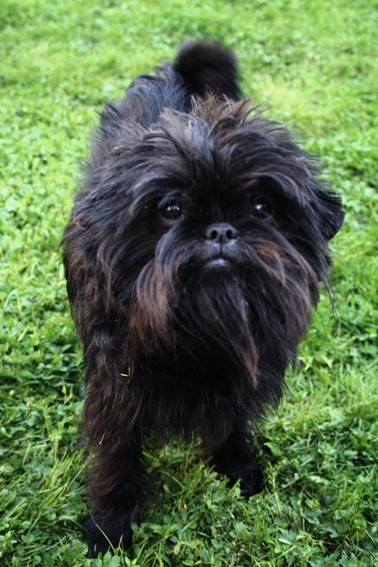 © Wikimedia.org/Ingunn Axelsen, CC BY
© Wikimedia.org/Ingunn Axelsen, CC BY
The Afghan Hound is a hound that is distinguished by its thick, fine, silky coat and its tail with a ring curl at the end. The breed is selectively bred for its unique features in the cold mountains of Afghanistan. Its local name is Tāžī Spay (Pashto: تاژي سپی) or Sag-e Tāzī (Dari: سگ تازی). Other names for this breed are Tāzī, Balkh Hound, Baluchi Hound, Barakzai Hound, Shalgar Hound, Kabul Hound, Galanday Hound or sometimes incorrectly African Hound. They have the ability to run and turn well. The Afghan Hound is tall, standing in height 61–74 cm (24–29 in) and weighing 20–27 kg (44–60 lb). The coat may be any colour, but white markings, particularly on the head, are discouraged; many individuals have a black facial mask. A specimen may have facial hair that looks like a Fu Manchu mustache, sometimes called 'mandarins'. Some Afghan Hounds are almost white, but parti-color hounds (white with islands of red or black) are penalized in the AKC standard, but not by the FCI. (Source: Wikipedia.org, CC BY-SA)
The Africanis is a dog landrace found across southern Africa. The Africanis is a medium-sized, lightly built dog with a long slender muzzle and, usually, a short coat. It has been described as resembling a cross between a Greyhound, a terrier and a dingo. It can be found in almost any colour or combination of colours, although fawns, browns, brindles and blacks with various white markings are common. A distinctive, possibly primitive, feature is a black patch found high on the outside of the tail where the caudal gland is found in the wild wolf. The Africanis usually stands between 50 and 62 centimetres (20 and 24 in). Being a landrace, minor variations in appearance may be common. The Africanis is nonetheless known to breed true to a recognisable form. (Source: Wikipedia.org, CC BY-SA)
The Aidi (Berber languages: ⴰⵢⴷⵉ, romanized: aydi, lit. 'dog') is a Berber dog breed native to the Atlas Mountains of North Africa and is used as a livestock guardian, protecting herds of sheep and goats. It is most commonly found in Morocco, which holds the standard under the Fédération Cynologique Internationale. The Aidi is also found in Algeria, Tunisia and Libya. It possesses hunting capabilities and good scenting ability. In Morocco, it is often paired in hunting with the Sloughi, which chases down prey that the Aidi has located by scent. Standing 52–62 cm (20–24 in) in height and weighing around 55 pounds (25 kg), the Aidi's lean, muscular body is protected by a coarse, thick, weather-resistant coat with a heavy plumed tail. The coat is heavy and soft. The head is bear-like and in proportion to the rest of the body. The breed has a tapered muzzle with a black or brown nose that usually matches the coat. Their jaws are strong with tight black or brown lips. The medium-sized ears are tipped forward and drop slightly. The eyes are medium, with a dark color and dark rims. Coat colours are white, black, black and white, pale red, and tawny. (Source: Wikipedia.org, CC BY-SA)
 © Wikimedia.org/HichamB, CC BY-SA
© Wikimedia.org/HichamB, CC BY-SA
The Airedale Terrier (often shortened to 'Airedale'), also called Bingley Terrier and Waterside Terrier, is a dog breed of the terrier type that originated in the valley (dale) of the River Aire, in the West Riding of Yorkshire, England. It is traditionally called the 'King of Terriers' because it is the largest of the terrier breeds. The Airedale was bred from the Old English Black and Tan Terrier (now known as the Welsh Terrier), the Otterhound and probably some other Terrier breeds, and has contributed to other dog breeds, such as the Yorkshire Terrier. Originally bred to serve as a versatile hunting and all around working farm dog, this breed has also been used as a war dog, guide dog, and police dog in Britain. In the United States, the breed has been used to hunt big game, upland birds, and water fowl, and serve in many other working capacities. (Source: Wikipedia.org, CC BY-SA)
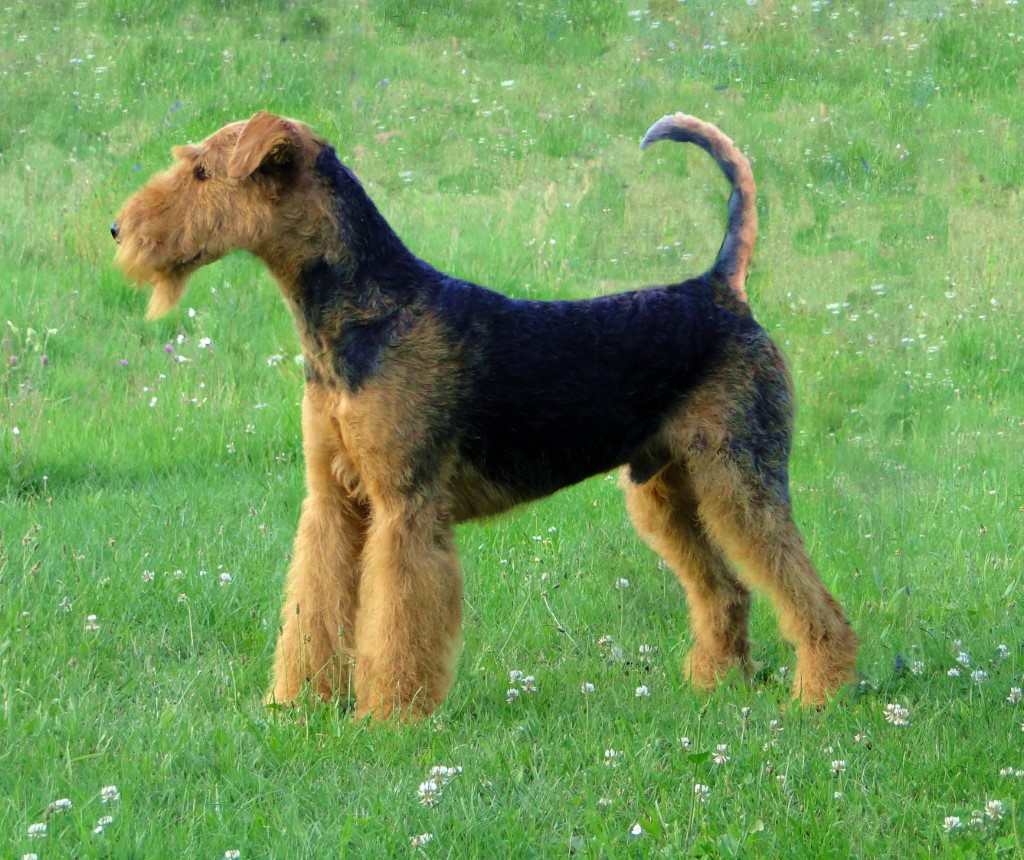 © Wikimedia.org/Zuni1520, CC BY-SA
© Wikimedia.org/Zuni1520, CC BY-SA
The Akbash (Turkish: Akbaş), is a traditional Turkish breed or type of flock guardian dog from western Anatolia. The word akbaş means 'white head', and thus distinguishes this dog from the Karabaş, or 'black head'.: 33 It was recognised by the Turkish Ministry of Agriculture and Rural Affairs in 2006; it is under the tutelage of the Köpek Irkları ve Kinoloji Federasyonu, the Turkish dog breed society, but is not recognised by the Fédération Cynologique Internationale. The Akbash is a flock guardian dog, providing protection from predators to shepherds and to their sheep; it does not have any herding ability.: 7 It is large and powerful dog:: 406 mean body weight is approximately 45 kg, and mean height at the withers just over 75 cm.: 6 (Source: Wikipedia.org, CC BY-SA)
The Akita (秋田犬, Akita-ken, Japanese pronunciation: [akʲita.keɴ]) is a historic dog breed of large size originating from the mountains of northern Japan. The two separate varieties of Akita are a pure Japanese strain, commonly called Akita-ken (ken is the on'yomi for inu meaning dog in Japanese), and a mixed American strain, commonly larger. The Akita has a short double coat similar to that of many other northern spitz breeds. The Akita is a powerful, independent, and dominant breed, commonly aloof with strangers, but affectionate and deeply loyal with its family. As a breed, Akitas are generally hardy. Historically they were used as guard dogs, fighting dogs and for the hunting of bears. (Source: Wikipedia.org, CC BY-SA)
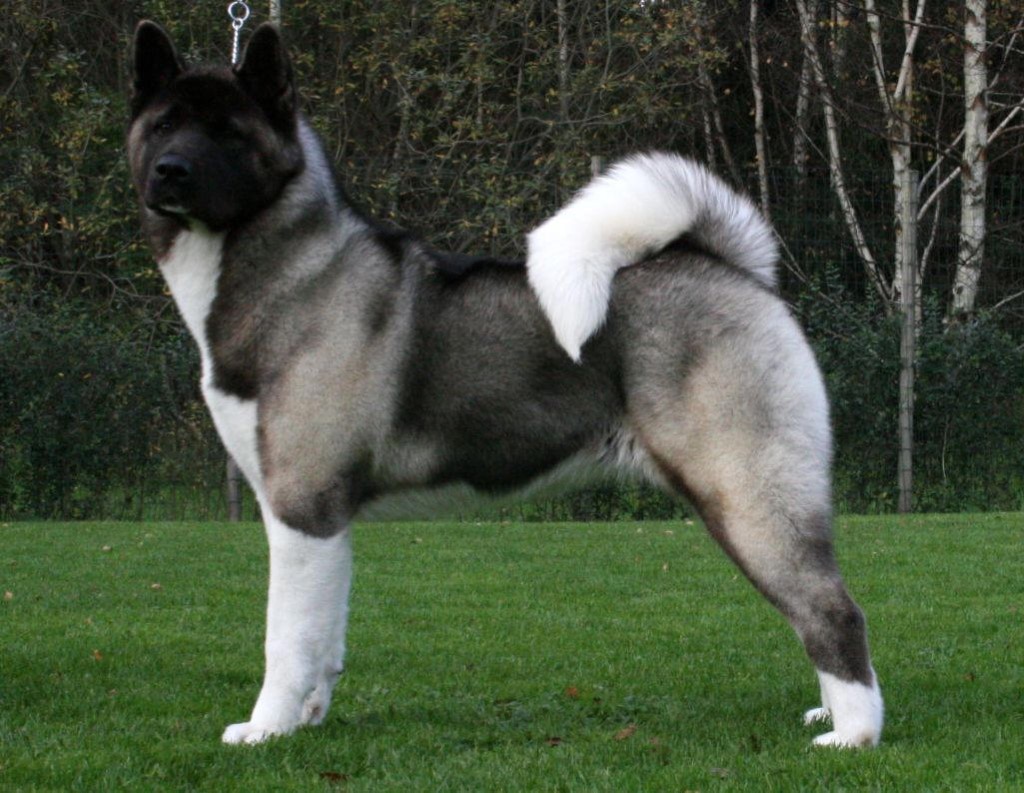 © Wikimedia.org/Jonnydrh, CC0
© Wikimedia.org/Jonnydrh, CC0
The Aksaray Malaklısı or Malaklı Karabaş is a Turkish breed of large livestock guardian dog, from the Aksaray Province in Central Anatolia. The Aksaray Malaklısı usually stands between 73 and 78 centimetres (29 and 31 in) at the withers, with a body length of some 79 and 83 centimetres (31 and 33 in). It is typically grey in colour with a black mask; the coat is short. The head and ears are large, the jowls are pendulous, and the tail is straight. The dogs only obey commands from the master, and can be aggressive with other people. They typically do not tolerate working with other dogs of the same sex. (Source: Wikipedia.org, CC BY-SA)
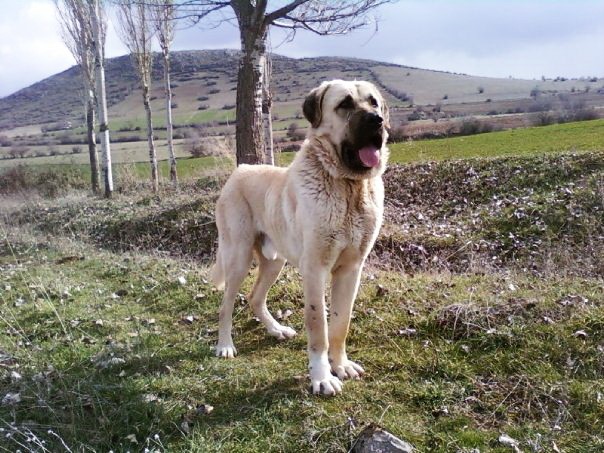 © Wikimedia.org/Birhanb, CC BY-SA
© Wikimedia.org/Birhanb, CC BY-SA
The Alano Español or Spanish Bulldog is a Spanish breed of medium to large sized dog of alaunt-bulldog type. It has at various times been used as a war dog, for bullfighting, for the management of cattle, for hunting and as a guard dog.: 498 In the later twentieth century it became an endangered breed; a recovery project was launched, and numbers have since recovered. It was officially recognised under national law in 2004. The Alano Español is a large dog of alaunt or bulldog type, with a large, strong head. Bitches stand some 55–60 cm at the withers, and weigh about 25–30 kg; dogs are on average about 3 cm taller and 5 kg heavier. (Source: Wikipedia.org, CC BY-SA)
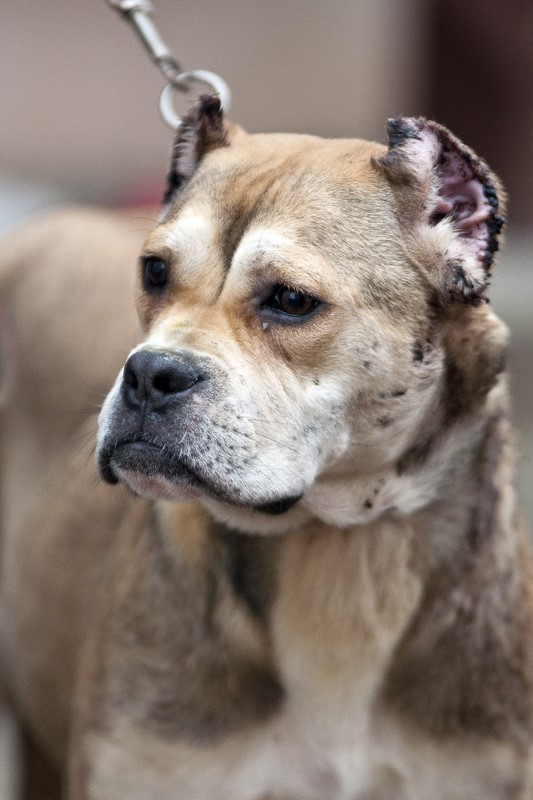 © Wikimedia.org/Ewa Ziemska, CC BY-SA
© Wikimedia.org/Ewa Ziemska, CC BY-SA
The Alapaha Blue Blood Bulldog is a breed of bulldog from the United States, and it is predominantly used as a guard dog. It is a very powerful, muscular breed with large head and brachycephalic muzzle. The hair coat is short, typically colored white with black, blue, buff or brown patches, and its tail is kept un-docked. Sexual dimorphism is common in the breed, with larger dogs typically twice the weight of smaller bitches. (Source: Wikipedia.org, CC BY-SA)
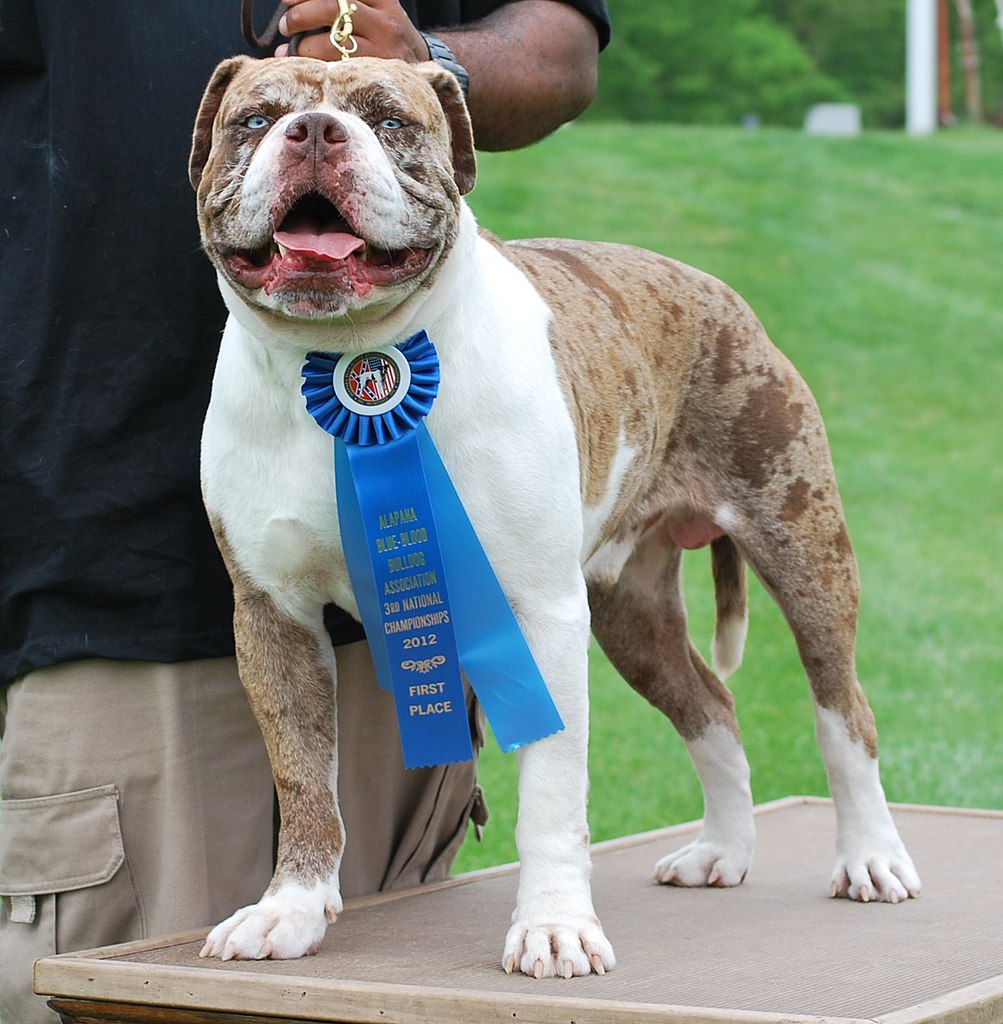 © Wikimedia.org/Mjrustline, CC BY-SA
© Wikimedia.org/Mjrustline, CC BY-SA
The Alaskan husky is a mix-breed of medium-sized working sled dog, developed specifically for its performance as such. Alaskan huskies are the most commonly used type of dog for competitive sled dog racing, both in short-distance sprint racing as well as long-distance expedition races such as the Iditarod Trail Sled Dog Race, the Yukon Quest, and the Finnmarkslopet. The Alaskan husky is not an officially recognized breed by any kennel club, nor does it have a formal breed standard.[citation needed] Unlike breeds developed for the show ring, the Alaskan husky is instead a product of careful selection for desirable sled dog traits from various other breeds, such as aptitude for pulling, endurance, speed, intelligence, appetite, and tolerance of extreme weather. (Source: Wikipedia.org, CC BY-SA)
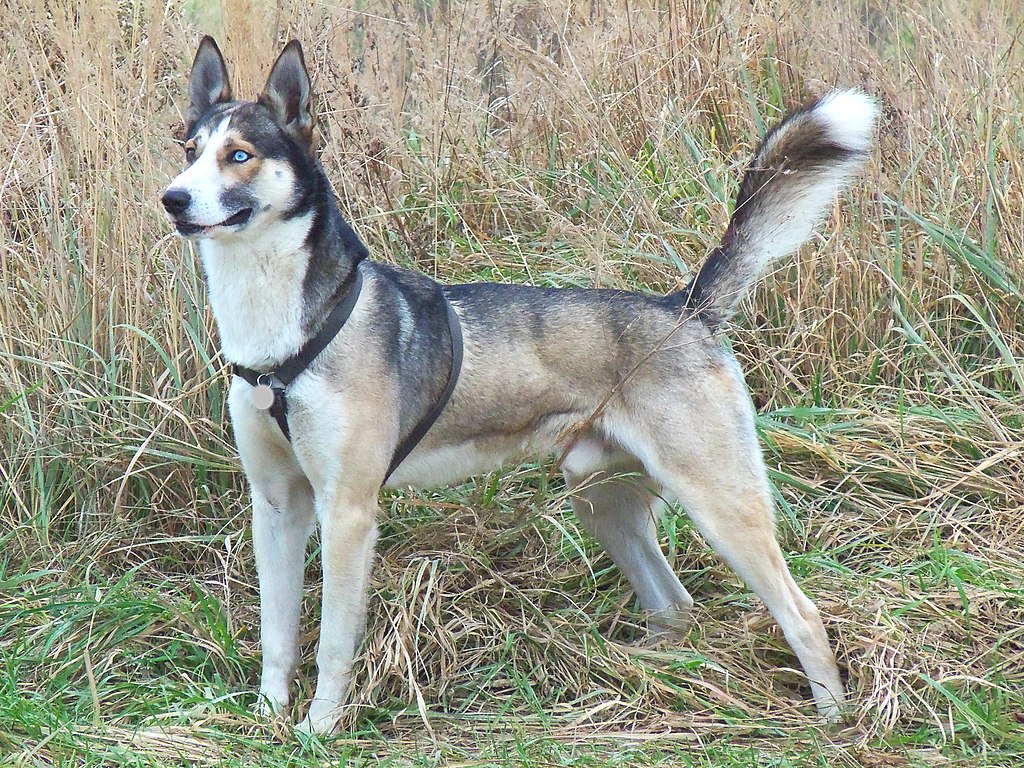 © Wikimedia.org/ZdeněkK, CC BY-SA
© Wikimedia.org/ZdeněkK, CC BY-SA
The Alaskan Klee Kai is a spitz-type breed of dog, developed in the late 20th century as a companion-sized dog resembling the larger Alaskan Malamute and Siberian Husky. It is an energetic, intelligent dog with an appearance that reflects its northern heritage. Bred in three sizes, its weight range is from 5 to 22 pounds as an adult, depending on whether its a standard, toy, or miniature. (Source: Wikipedia.org, CC BY-SA)
The Alaskan Malamute (/ˈmæləˌmjuːt/) is a large breed of dog that was originally bred for its strength and endurance to haul heavy freight as a sled dog and hound. It is similar to other arctic breeds such as the husky, the spitz, the Greenland Dog, Canadian Eskimo Dog, the Siberian Husky, and the Samoyed. (Source: Wikipedia.org, CC BY-SA)
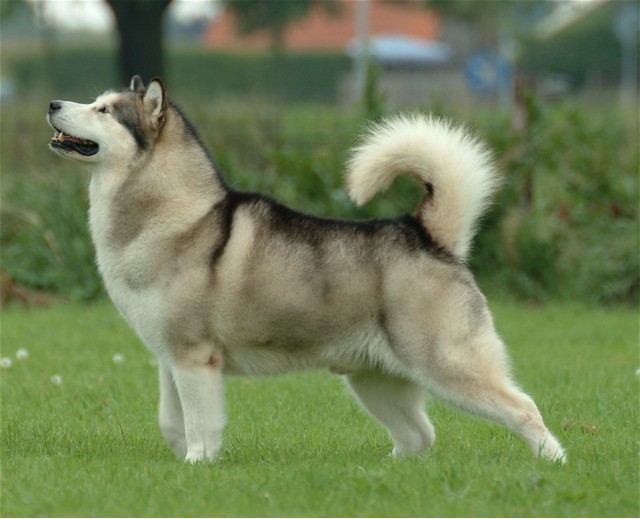 © Wikimedia.org/SCMW, CC BY
© Wikimedia.org/SCMW, CC BY
The Alopekis (Greek: Αλωπεκίς) is a small, foxlike dog from Greece with pricked ears, a sickle-shaped tail, and a smooth short coat. The dog is found in the Serres region of Greece and dates before 1922.[unreliable source?] The alopekis is believed to be a landrace that descended from a type of small dog common to the Balkan peninsula, although some claim it descends from eastern pye dogs. Alopekis numbers have declined to the point of near extinction in the last half-century, a situation further exacerbated by the mass sterilisation of dogs in some regions to reduce the number of strays, although it still survives in small populations in Northern Greece. Recent efforts have been made to identify surviving populations and save the type. (Source: Wikipedia.org, CC BY-SA)
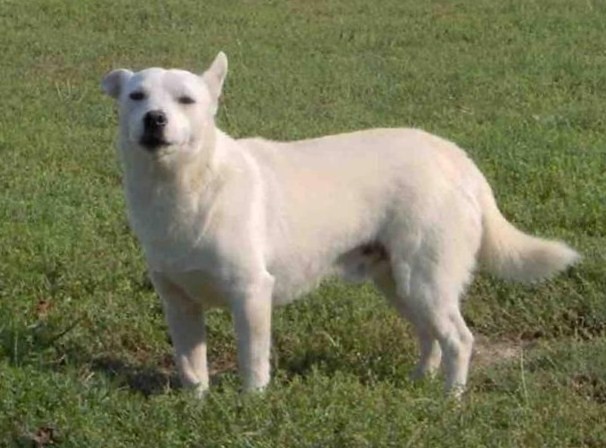 © Wikimedia.org/S. Chleiounakis, GFDL
© Wikimedia.org/S. Chleiounakis, GFDL
The Alpine Dachsbracke (German: Alpenländische Dachsbracke) is a small breed of dog of the scent hound type originating in Austria. The Alpine Dachsbracke was bred to track wounded deer as well as boar, hare, and fox. It is highly efficient at following a trail even after it has gone cold. The Alpine Dachsbracke is very sturdy, and Austria is said to be the country of origin. This small dog has a slight resemblance to a Dachshund, with short legs (although longer than a dachshund's) and a long body. The coat is dense, short but smooth except for the tail and neck. The round eyes have a lively expression. Being very sturdy, the Alpine Dachsbracke is visibly robust and has a big boned structure. (Source: Wikipedia.org, CC BY-SA)
The American Bulldog is a large, muscular breed of mastiff-type that were used as stock dogs, catch dogs, and guardians on farms and ranches. They are descended from the Old English Bulldog, which is thought to have arrived in America as early as the 17th century, brought over by working-class immigrants from England. During WWI and WWII, the breed was on the verge of extinction, with the only surviving dogs being kept primarily on farms in the southeast. John D. Johnson and Alan Scott are widely regarded as the forefathers of rescuing the breed from extinction. On January 1, 1999 the United Kennel Club first recognized the American Bulldog. In November 2019, the American Bulldog was added to the American Kennel Club (AKC) Foundation Stock Service (FSS). (Source: Wikipedia.org, CC BY-SA)
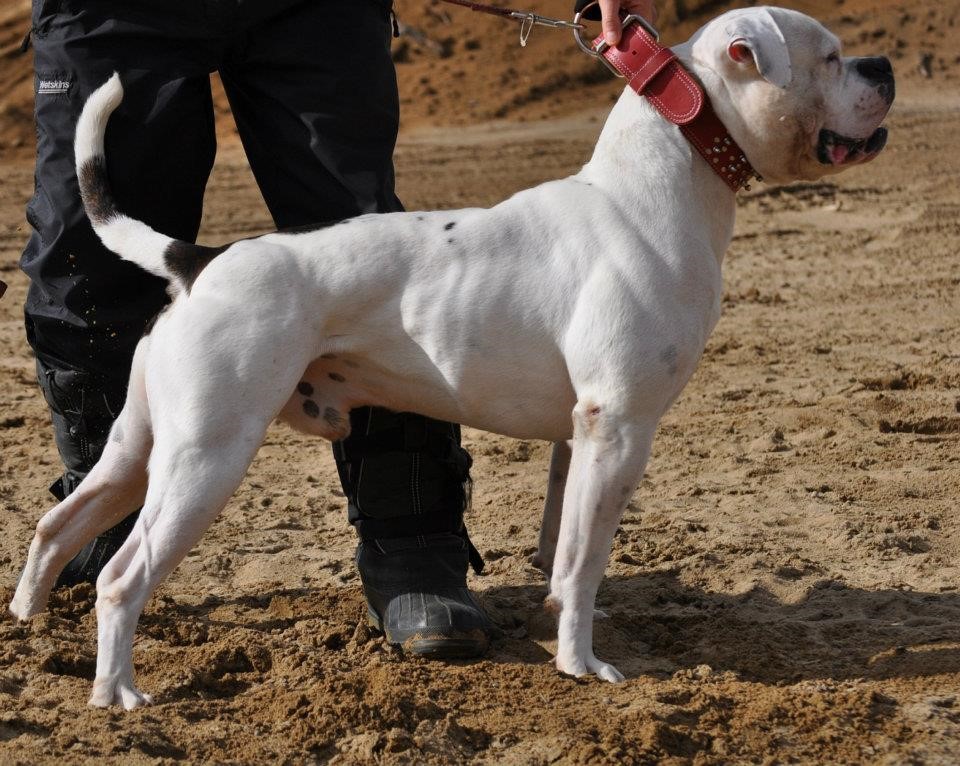 © Wikimedia.org/Justayton, CC BY-SA
© Wikimedia.org/Justayton, CC BY-SA
The American Bully is a modern breed of dog that was developed as a companion dog, and originally standardized and recognized as a breed in 2004 by the American Bully Kennel Club (ABKC). Their published breed standard describes the dog as giving the 'impression of great strength for its size'. In 2008, the American Bully was recognized by the European Bully Kennel Club (EBKC), and on July 15, 2013, by the United Kennel Club (UKC). Neither The Kennel Club nor American Kennel Club (AKC) have recognized or accepted the American Bully into their registry as a purebred dog. The founding registry (ABKC) divided the American Bully into four categories, including the Pocket, Standard, Classic, and XL, whereas other registries, including the UKC, have approved one consistent size standard. There are several types, ranging from pocket to XXL in size and weight. Temperament in adult dogs is very much dependent on training, and the breed can be very demanding and needs to be properly trained. (Source: Wikipedia.org, CC BY-SA)
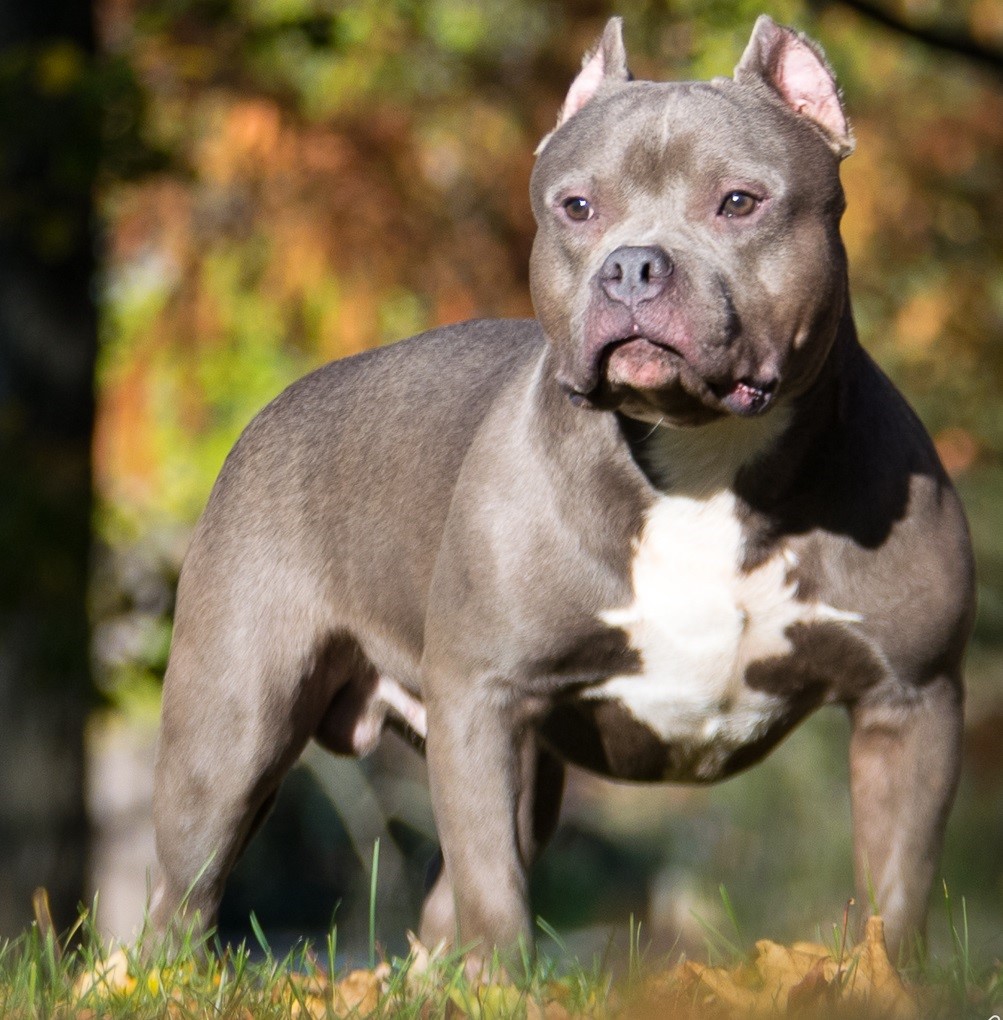 © Wikimedia.org/BullyB6>, CC BY-SA
© Wikimedia.org/BullyB6>, CC BY-SA
The American Cocker Spaniel is a breed of sporting dog. It is a spaniel type dog that is closely related to the English Cocker Spaniel; the two breeds diverged during the 20th century due to differing breed standards in the US and the UK. In the United States, the breed is usually called a Cocker Spaniel, while elsewhere in the world, it is called an American Cocker Spaniel to distinguish it from its older English cousin. The word cocker is commonly held to stem from their use to hunt woodcock in England, while spaniel is thought to be derived from the breed's origins in Spain. (Source: Wikipedia.org, CC BY-SA)
The English Coonhound, also referred to as the American English Coonhound (by the American Kennel Club only) or the Redtick Coonhound, is a breed of coonhound that originated in and is typically bred in the Southern United States. It is descended from hunting hounds, especially foxhounds, brought to America by settlers during the 17th and 18th centuries. The breed's first recognition came from the United Kennel Club in 1905 as the English Fox and Coonhound. Further recognition has been granted in recent years by the American Kennel Club, first in the Foundation Stock Service and in 2011 as a fully recognized member of the hound group. (Source: Wikipedia.org, CC BY-SA)
The American Eskimo Dog is a breed of companion dog, originating in Germany. The American Eskimo Dog is a member of the Spitz family. It is considered an ancient dog breed due to its recent admixture with wolves. The breed's progenitors were German Spitz, but due to anti-German sentiment during the First World War, it was renamed 'American Eskimo Dog.' Although modern American Eskimo Dogs have been exported as German Spitz Gross (or Mittel, depending on the dog's height), the breeds have diverged and the standards are significantly different. In addition to serving as a watchdog and companion, the American Eskimo Dog also achieved a high degree of popularity in the United States in the 1930s and 1940s as a circus performer. (Source: Wikipedia.org, CC BY-SA)
The American Foxhound is a breed of dog that is a cousin of the English Foxhound. They are scent hounds, bred to hunt foxes by scent. While standards call for the American Foxhound to be about 21–25 in (53–64 cm) tall to the withers, and weigh anywhere between 55–71 lb (25–32 kg), many of them are larger in structure (especially the show strains), with males standing 26–29 in (66–74 cm) and females 25–28 in (64–71 cm) and smaller in weight, typically between 45–65 lb (20–29 kg). The legs of a Foxhound are long and straight-boned. The foxhound's chest is rather narrow. It has a long muzzle, and a large, domed skull. The ears are wide and low-set. The eyes are hazel or brown, and are large and wide-set. (Source: Wikipedia.org, CC BY-SA)
The American Hairless Terrier is a breed of companion dog from the United States that was developed from naturally hairless Rat Terriers. According to the United Kennel Club’s breed standard, American Hairless Terriers typically stand between 10 and 18 inches (25 and 46 cm); the breed typically weighs between 7 and 14 pounds (3.2 and 6.4 kg). The breed has pricked ears and can be born with either a naturally short tail or a long tail that is never docked. (Source: Wikipedia.org, CC BY-SA)
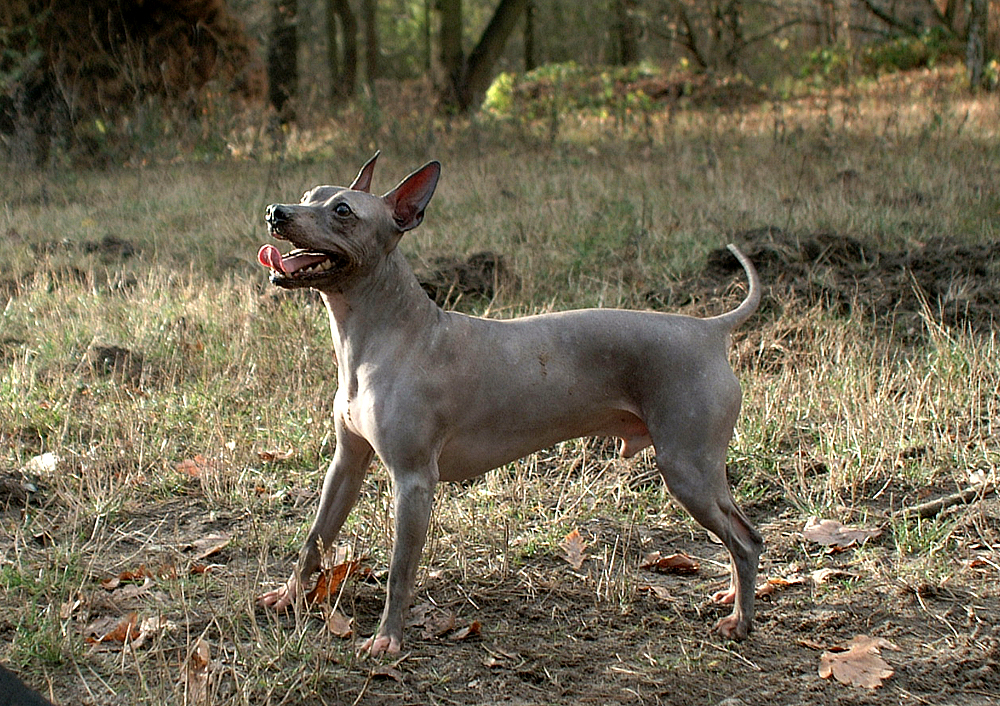 © Wikimedia.org/Nyaah, CC BY
© Wikimedia.org/Nyaah, CC BY
The American Pit Bull Terrier (APBT) is a dog breed recognized by the United Kennel Club (UKC) and the American Dog Breeders Association (ADBA), but not the American Kennel Club (AKC). It is a medium-sized, short-haired dog, of a solid build, whose early ancestors came from the British Isles. When compared with the English Staffordshire Bull Terrier, the American Pit Bull Terrier is larger by margins of 6–8 inches (15–20 cm) in height and 25–35 pounds (11–16 kg) in weight. The American Pit Bull Terrier varies in size: males are normally about 18–21 inches (45–53 cm) in height and around 35–60 pounds (15–27 kg) in weight, while females are normally around 17–20 inches (43–50 cm) in height and 30–50 pounds (13–22 kg) in weight. (Source: Wikipedia.org, CC BY-SA)
The American Staffordshire Terrier, also known as the AmStaff or American Staffy is a medium-sized, short-coated American dog breed. The height of an American Staffordshire Bull Terrier is 17–19 in (43–48 cm) tall and weighs between 40–70 lb (18–32 kg). The American Kennel Club (AKC) describes the breed as 'confident, smart and good-natured'. American Staffordshire Terriers are similar to American Pit Bull Terriers, though the American Pit Bull Terrier is not recognized by the American Kennel Club. The breed was accepted by the AKC in 1936. It should not be confused with the Staffordshire Bull Terrier of the United Kingdom. (Source: Wikipedia.org, CC BY-SA)
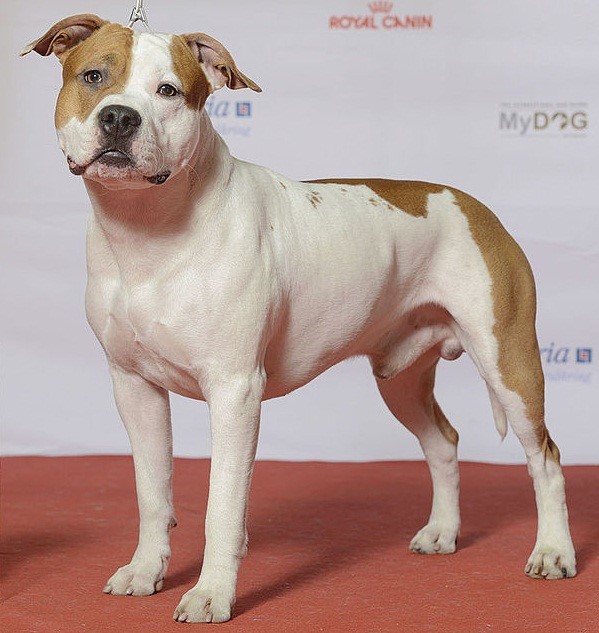 © Wikimedia.org/Svenska Mässan, CC BY-SA
© Wikimedia.org/Svenska Mässan, CC BY-SA
The American Water Spaniel (often abbreviated to AWS) is a breed of spaniel which originated in the United States. It was developed in the state of Wisconsin during the 19th century from a number of other breeds, including the Irish and English Water Spaniels. The breed was saved by Dr. Fred J. Pfeifer, who set up the breed club and standard, and whose work led to recognition for the breed by the United Kennel Club, and later, the American Kennel Club. While they are the state dog of Wisconsin, they remain a rare breed. They are medium-sized dogs, and have a double layered coat, which comes in a variety of brown related shades. A versatile hunting dog, they are also suitable for apartment life due to work by breeders to develop a breed with an even temperament. The AWS may have been involved in the development of the Boykin Spaniel. (Source: Wikipedia.org, CC BY-SA)
The Andalusian hound or Podenco Andaluz is an ancient Spanish breed of warren hound used to hunt small game in Andalusia, Spain. It is one of four podenco breeds recognized by the Real Sociedad Canina de España. It is an agile dog generally used to hunt ducks, rabbits, boar and fowl. There are three accepted sizes (small, medium and large) and three coat types (wire-haired, long-haired and smooth). There are three sizes – large, medium and small – and three types of coat – wire-haired (Spanish: Cerdeño), long-haired (Spanish: Sedeño) and smooth. This combination of factors can results in nine different varieties. This variability may be the result of adaptation to the different microclimates within Andalusia, including mountains, agricultural land and marshes, as well as the diverse game targeted by hunters. Coat colors ranges from white to deep red. Podenco Andaluz have a trot as fast as their gallop. (Source: Wikipedia.org, CC BY-SA)
The Anglo-Français de Petite Vénerie is a medium-sized breed of dog used in hunting as a scenthound, usually in packs. It is one of the Anglo-French hound breeds which were created by crossing French scenthounds with English (Anglo) foxhounds. The name Petite Vénerie does not mean that dogs of the breed are petite or small, but rather that it is used to hunt small game. (Source: Wikipedia.org, CC BY-SA)
The Appenzeller Sennenhund is a Swiss breed of medium-sized working dog. It originates in the Appenzell region of north-eastern Switzerland, and is one of four regional breeds of Sennenhund or Swiss mountain dog, all of which are characterised by a distinctive tricolour coat. (Source: Wikipedia.org, CC BY-SA)
 © Wikimedia.org/SportKBK, CC BY-SA
© Wikimedia.org/SportKBK, CC BY-SA
The Ariégeois is a French breed of medium-sized scent hound from the département of Ariège in the Midi-Pyrenées region of southern France. It may have derived from cross-breeding of pack-hunting hounds such as the Grand Bleu de Gascogne or Grand Gascon-Saintongeois with local Briquet dogs. It hunts either alone or in a pack, and is used both as a courser and for driving game to waiting guns. While most successful with hares, it is also used for hunting deer and boar. It does not adapt well to urban life, and is not usually kept as a companion dog. (Source: Wikipedia.org, CC BY-SA)
The Armant (also known as the Egyptian Sheepdog or Ermenti) is a breed of herding dog from Egypt. It is believed the Armant descends from Briards brought to Egypt by Napoleon's armies, these dogs were likely crossed with local dogs to produce the first examples of the breed. The Armant is named after the town of Armant in Egypt, the supposed place of origin of the breed, the breed is not very well known but is used extensively within Egypt as both a herding dog and a guard dog. (Source: Wikipedia.org, CC BY-SA)
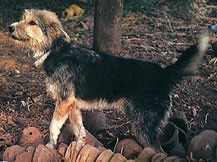 © Wikimedia.org/VideofindersTV, CC0
© Wikimedia.org/VideofindersTV, CC0
The Armenian Gampr (Armenian: Գամփռ, romanized: Gamp’ṙ) is an Armenian breed of flock guardian dog native to the Armenian Highlands. It falls within the Ovcharka group of livestock guardian dogs, which can be found throughout the Transcaucasus area. It was recognised in 2011 by the International Kennel Union in Moscow, under the guidance of the Armenian Kennel Club, which had developed the breed standard in the 1990s. The Gampr is a large and powerful dog, weighing some 50 kg and standing at least 60 cm at the withers, with the usual sexual dimorphism – dogs are somewhat larger and heavier than bitches. The coat may be of any colour; it may be short or long, and always has a soft undercoat.: 65 (Source: Wikipedia.org, CC BY-SA)
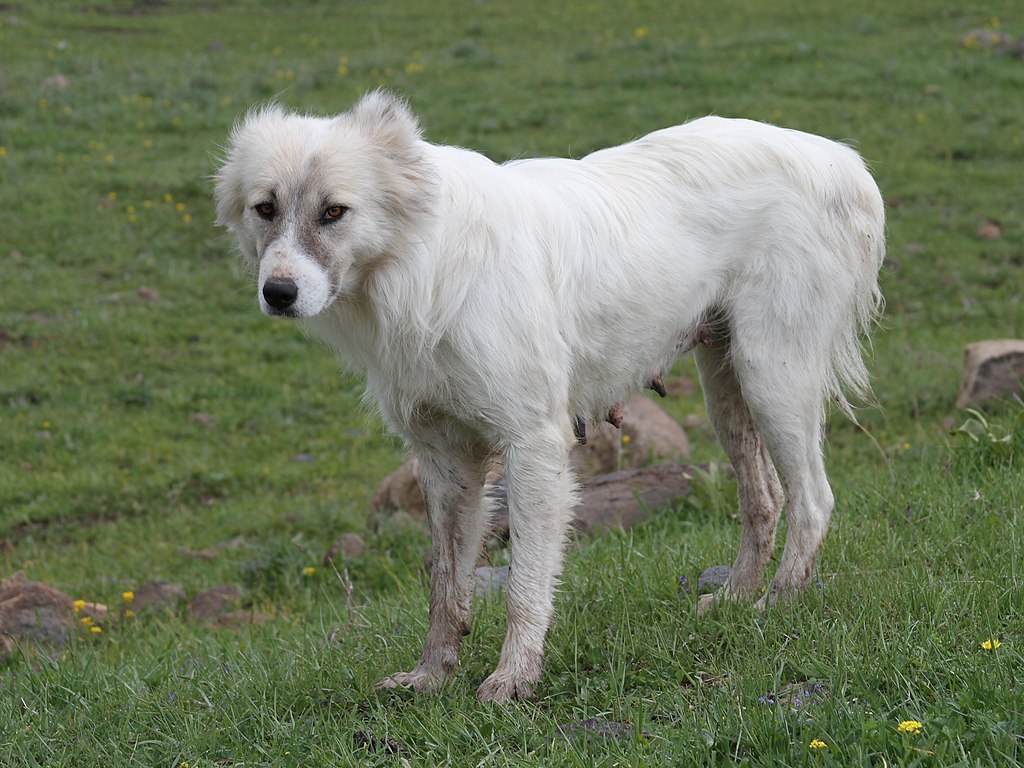 © Wikimedia.org/Gampr1, CC BY-SA
© Wikimedia.org/Gampr1, CC BY-SA
The Australian Cattle Dog (ACD), or simply Cattle Dog, is a breed of herding dog originally developed in Australia for droving cattle over long distances across rough terrain. This breed is a medium-sized, short-coated dog that occurs in two main colour forms. It has either red or black hair distributed fairly evenly through a white coat, which gives the appearance of a 'red' or 'blue' dog. As with dogs from other working breeds, the Australian Cattle Dog is energetic and intelligent with an independent streak. It responds well to structured training, particularly if it is interesting and challenging. It was originally bred to herd by biting, and is known to nip running children. It forms a strong attachment to its owners, and can be protective of them and their possessions. It is easy to groom and maintain, requiring little more than brushing during the shedding period. The most common health problems are deafness and progressive blindness (both hereditary conditions) and accidental injury; otherwise, it is a robust breed with a lifespan of 12 to 16 years. (Source: Wikipedia.org, CC BY-SA)
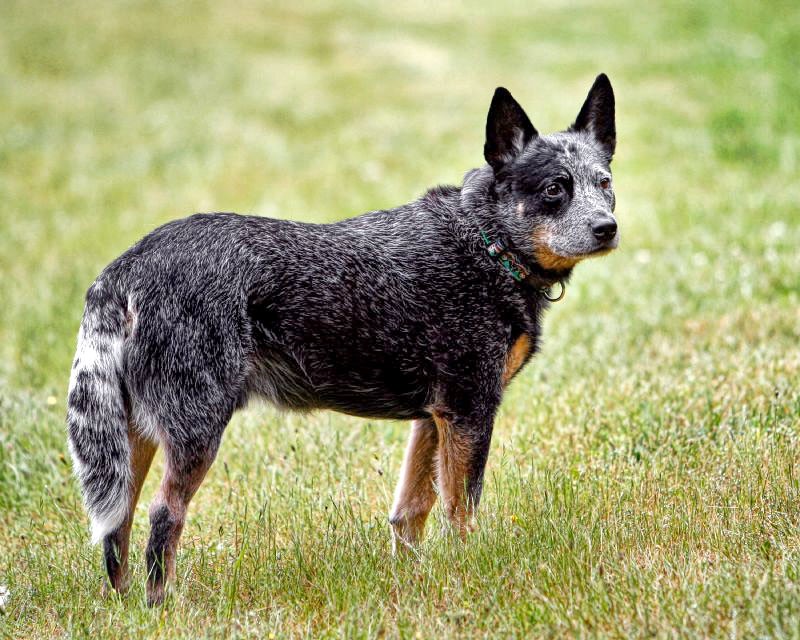 © Wikimedia.org/Zingpix, CC BY
© Wikimedia.org/Zingpix, CC BY
The Australian Kelpie, or simply Kelpie, is an Australian sheepdog capable of mustering and droving with little or no guidance. It is a medium-sized dog and comes in a variety of colours. The Kelpie has been exported throughout the world and is used to muster livestock, primarily sheep, cattle and goats. The breed has been separated into two distinct varieties: the Show (or Bench) Kelpie and the Working Kelpie. The Show Kelpie is seen at conformation dog shows in some countries and is selected for appearance rather than working instinct, while the Working Kelpie is bred for working ability rather than appearance. (Source: Wikipedia.org, CC BY-SA)
The Australian Shepherd is a breed of herding dog from the United States. The name of the breed is technically a misnomer, as it was developed in California in the 19th century; the breed was unknown in Australia at the time. It is claimed that Australian Shepherds descend from a variety of herding breeds, including collies imported, alongside sheep, from Australia and New Zealand; the breed reportedly took its name from this trade. Originally used solely as a herding dog, the Australian Shepherd has become one of the most popular companion dog breeds in North America. (Source: Wikipedia.org, CC BY-SA)
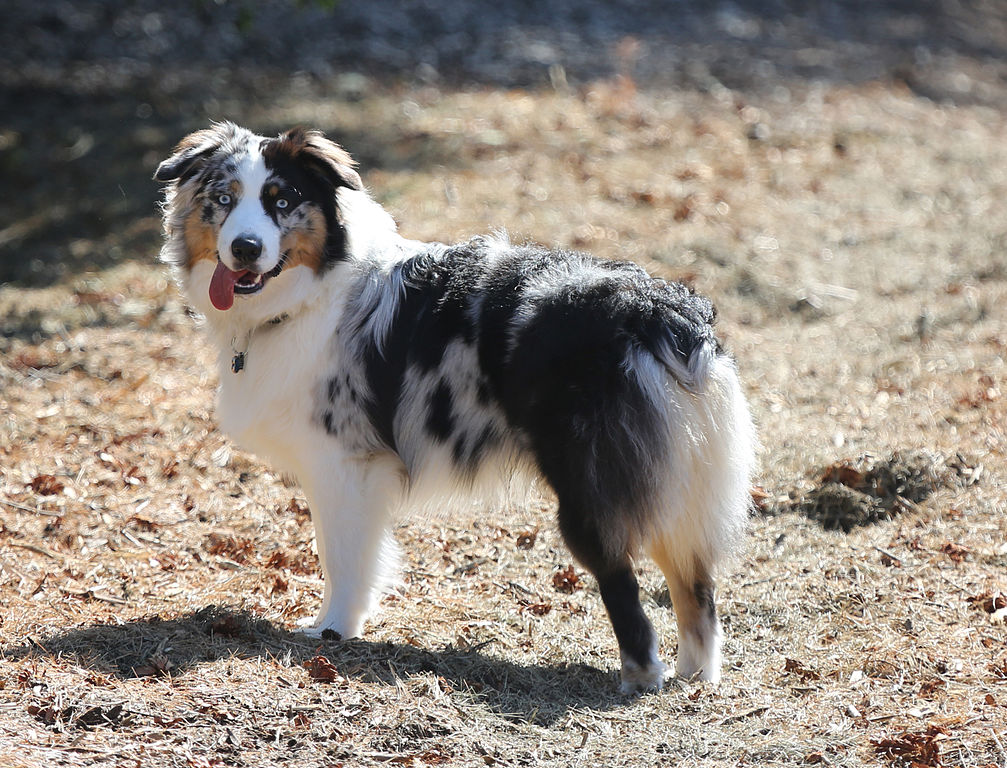 © Wikimedia.org/GizaDog, CC BY-SA
© Wikimedia.org/GizaDog, CC BY-SA
The Australian Terrier is a small breed of dog of the terrier dog type. The breed was developed in Australia, although the ancestral types of dogs from which the breed descends were from Great Britain. The Australian Terrier is a small dog with short legs, weighing around 6.5 kilograms (14 lb) and standing about 25 centimetres (9.8 in) at the withers, with a medium length shaggy harsh double coat that is not normally trimmed. Fur is shorter on the muzzle, lower legs, and feet, and there is a ruff around the neck. The coat colours are blue or silver and tan with a lighter coloured topknot, and with markings on face, ears, body and legs of a colour described in the breed standard as 'tan, never sandy', or a solid red with a sandy variation. The tail was traditionally docked, in order to protect the dog from spinal injury while working and hunting in the field. As with most pet dog breeds, all proportions and aspects of the body and head as well as colours and markings are extensively described in the breed standard. (Source: Wikipedia.org, CC BY-SA)
 © Wikimedia.org/Ketterechts, CC0
© Wikimedia.org/Ketterechts, CC0
The Austrian Black and Tan Hound is a breed of dog originating in Austria. Colouring in this breed is highly important; it must be black with small, clearly defined, light to dark fawn markings. Two fawn marks above the eyes must be present. The coat is smooth, dense and short (about 2 cm in length). The long tail is slightly bent and the ears are medium in length and lie flat with rounded tips. Males are 50–56 centimetres (20–22 inches), while females are 48–54 centimetres (19–21 inches). They weigh 15 to 22 kg (33-49 pounds). (Source: Wikipedia.org, CC BY-SA)
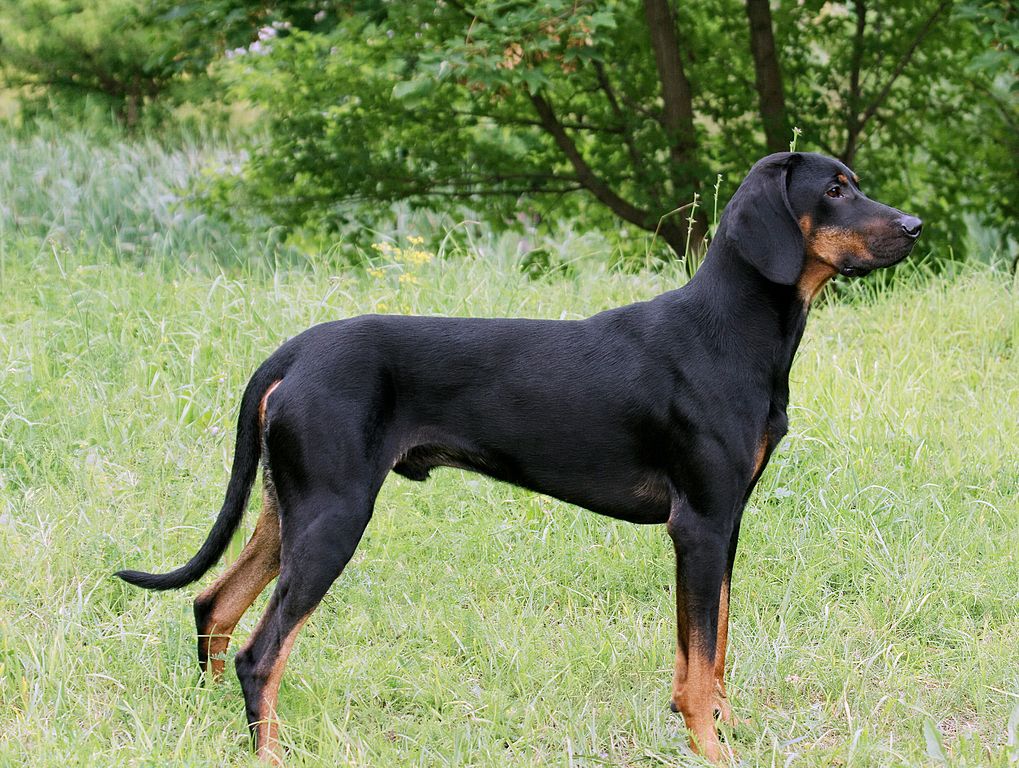 © Wikimedia.org/Янковский Евгений, CC BY-SA
© Wikimedia.org/Янковский Евгений, CC BY-SA
The Austrian Pinscher (Österreichischer Pinscher) is a medium-sized breed of pinscher-type dog from Austria, where dogs of the type were originally farm dogs, keeping barns free of rats and acting as home guards, livestock guardians, and drovers. The name originally given to the breed in 1928 was the Österreichischer Kurzhaarpinscher (Austrian Shorthaired Pinscher) to differentiate it from similarly named breeds, but today in its country of origin the breed is officially called the Österreichischer Pinscher, or Austrian Pinscher in English. (Source: Wikipedia.org, CC BY-SA)
The Azawakh is a breed of dog from West Africa. With ancient origins, it is raised throughout the Sahelian zone of Mali, Niger, and Burkina Faso. This region includes the Azawagh Valley for which the breed is named. While commonly associated with the nomadic Tuareg people, they are also bred and owned by other ethnic groups such as the Peulh, Bella, and Hausa. The Azawakh is more related to the Sloughi than it is to the Saluki. (Source: Wikipedia.org, CC BY-SA)
The Bakharwal dog is found in northern India. It is an ancient working Indian dog breed found in Ladakh and across the Pir Panjal Range of India, where it has been bred for many centuries by the Bakarwal and Gujjar nomadic tribes, as a livestock guardian dog and settlement protector. While the Bakharwal Dog is mainly found in India, it is found in smaller numbers in Afghanistan and Pakistan. A recent study says that this breed is on the verge of extinction and Bakerwal community has appealed to include this animal in the endangered species category. Of late, there were many cases when this mountain breed of dog contracted rabies or was shot by separatist militants. (Source: Wikipedia.org, CC BY-SA)
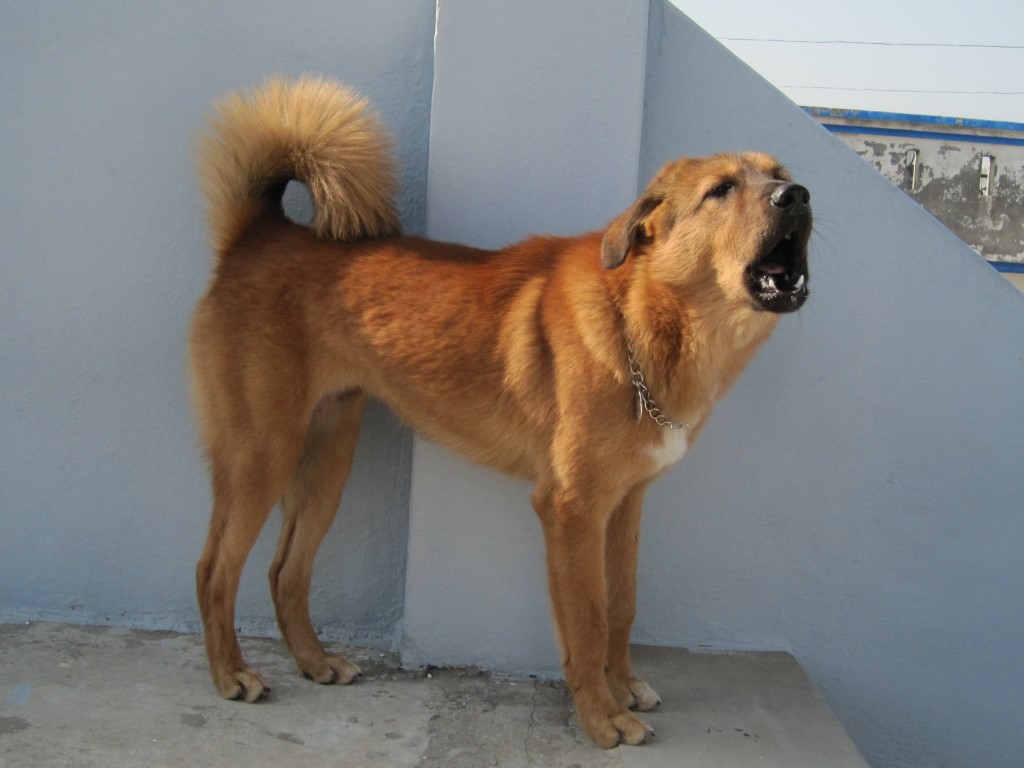 © Wikimedia.org/User7051399901, CC BY-SA
© Wikimedia.org/User7051399901, CC BY-SA
The Banjara Hound, also known as the Vanjari Hound, is a breed of dog found in India. It is a sighthound-type dog bred and used for hunting by the nomadic Banjara of Maharashtra. The Banjara Hound is a rough-coated breed of sighthound, usually brindle or solid-coloured. It resembles a large Saluki, standing around 28 in (71 cm), and is famed for its stamina and ability to pull down deer. (Source: Wikipedia.org, CC BY-SA)
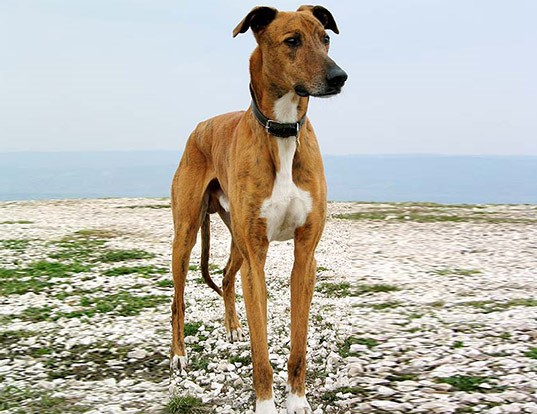 ©
©

Time for recess! Post a comment, ask a question or write a review. Feel free to let us know what you think!
yo soy de El Salvador y me llamo Helen Ingrid Pero tube que venirme para los estados Unidos
tengo 14 años y la mayoria me salio bien y no estudie ni nada solo por que mi padre me enseño cuando salia de viaje con el
Muy buenos videos, las orientaciones son excelentes, importantes para evitar accidentes
something in this test is not right. there were only 2 questions that i crossed out with an and you can check that it is a system error and not main. And i have already done this test 3 Times and it does the same thing to me.
Muchas gracias, por permitir aprender y por hacerlo sin costo alguno. Muy . Felicitaciones. He visto libros que ofertan Online en todos los idiomas y Aplicaciones que me han comentado que resultan cuando son pagadas. Igual los libros los ofrecen con Vídeos, exámen simulado y de diferentes formas, el cliente lo elije y paga. Pero lo que ofrecen gratuito es valiosa ayuda, pero quizás lo determinante y recomendable es comprar para ir a lo seguro y después ir a la Escuela.
Gracias por los ejemplos para el test. Una pregunta, alguien ha pasado el exámen estudiando de aqui? Yo ya hice el exámen en inglés y las preguntas eran bastante complejas. Hablo el inglé igual que el espanol pero ahora quiero tratar en espanol a ver si asi lo paso... Si alguien lo ha pasado solo con edsto o sabe de algun libro porfa me avisa? Gracias!!!
TEST ACTUALIZADO a 2024 con todas las preguntas revisadas acá: https://www.daypo.com/examen-teorico-manejo-sertracen-panama-2024-actualizado.html